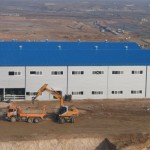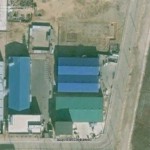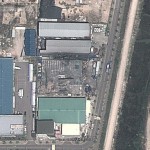Pictured Above: (TL) A Picture of the Living Art/Sonoko Factory (source) (TR) A Google Earth Image of the Factory (B) The remains of the fire
UPDATE 4 (2012-1-16): The Living Art/Sonoko Factory has burned down. According to Yonhap:
For Kim Suck-chul, Christmas 2010 was a nightmare that nearly cost him his fledging factory in North Korea.
Kim was the first South Korean businessmen to make an inroad into the joint inter-Korean industrial complex in the North Korea’s western border city of Kaesong.
Kim set up his factory in Kaesong in late 2004 to produce kitchenware and hired some 350 North Korean workers.
[…]
Cooking pots made in the North were brought to South Korea for sale in late 2004, where they made headlines and quickly sold out in a major department store. The kitchenware was later exported to Mexico and Germany also.
A pre-dawn fire on Christmas Eve, 2010, destroyed half of Sonoko Cuisineware’s factory in the Northern economic enclave, costing Kim about 2 billion won (US$1.7 million).
The fire began in a shipping container in the factory’s compound after North Korean workers did not switch off an electric pad and electric heater the previous day, Kim said.
He said the South Korean authorities had inadequate fire fighting measures for the South Korean factories in the complex.
“Firefighters came to the scene more than 40 minutes after the fire tore through the factory,” Kim told Yonhap News Agency by phone from his office in Ilsan, west of Seoul.
He said a fire engine and water wagon came from a fire station just 300 meters away, though the water wagon held so little water it had to return to the station to refill before coming back to the scene.
The blaze completely destroyed machines and other equipment in the factory, bringing the operation to a halt for more than a year.
“All of my North Korean employees are working for other South Korean factories in the complex as I could not pay them wages,” Kim said. He added that four of his eight South Korean workers had either quit or taken leaves of absence.
Kim said he has yet to recover from the devastating damage due to financial constraints.
He sent official documents to former and then current unification ministers on four occasions between April and October of last year to try to secure financial assistance to resume operations, but was only told to “wait.”
Out of frustration, he posted his latest appeal on the Web site of the Unification Ministry, which handles inter-Korea affairs.
“I’m in deathly agony and I can not sleep,” he said. In a worst-case scenario, he said, he may file a suit against the government over the issue.
Unification Ministry spokesman Kim Hyung-suk indicated the government can not give special favors to the kitchenware manufacturer, saying it needs to exercise fairness in its handling of the more than 120 South Korean companies in the complex.
Despite lingering tensions on the Korean Peninsula, the two Koreas have kept intact the shared complex that serves as a key legitimate cash cow for North Korea.
UPDATE 3 (2006-11-28): Living Art and Sonoko managers indicted for embezzlement. According to the Korea Herald:
Prosecutors yesterday indicted the chief executives of two kitchenware manufacturers that operated a joint venture in North Korea’s Gaeseong industrial complex on charges of embezzling government funds granted to promote inter-Korean ties. One was also charged for delaying salary payments for his employees.
This is the first time any business concern in the industrial complex has faced criminal charges.
The Seoul Central Prosecutors Office charged Kim Seok-chul, the chairman of Sonoko Cuisineware Inc., and Kang Man-soo, head of Living Art Co., for colluding to embezzle 300 million won – part of the 3 billion won in government loans which they received as aid for investing in Gaeseong.
The two companies set up a joint venture in Gaeseong in 2004 under the name of Living Art. The kitchenware maker began to use the name of Sonoko in January this year after Living Art pulled out of the venture three months earlier citing financial difficulties.
“After receiving the loans on Oct. 26, 2004, Kim and Kang took the total amount of money in a month,” said a prosecutor investigating the case, declining to be identified.
The prosecutor said Kim and Kang used part of the money to pay their personal debts.
The government funds were extended as low-interest loans, sums of which Living Art redeemed before going bankrupt. Sonoko Cuisineware is reportedly covering the monthly interest payments as it has been independently operating in Gaeseong to produce pots, pans and other kitchenware. The two companies dissolved their partnership in October of last year.
Prosecutors said Kim is also charged of violating inter-Korean economic exchange laws after providing factories in Gaeseong to three different companies where had no business approval by the Unification Ministry which oversees all inter-Korean businesses.
Prosecutors suspect Kim had approached investors by promising to help them gain entry into North Korea, and allegedly led an investors visit to Gaeseong in June of this year with false identities provided by Sonoko.
Prosecutors also accused Kim of delays in payment of salaries to his employees to the tune of over 20 million won in October 2004.
Kim also sent gifts such as expensive imported liquors to North Korean officials in return for business favors. He claimed to have used his own money for the gifts.
The history of Sonoko and Living Art dates back to before Living Art was selected to enter the Gaeseong pilot project in 2004.
Kim was then in charge of exports at Living Art. He persuaded the company to set up a plant in Gaeseong.
Living Art was to invest in the manufacturing equipment, while Kim financed the plant-building.
The 3 billion won of government loans were for building the production facility, but Kim reportedly claimed Living Art failed to pay for the equipment.
Living Art was feted for manufacturing the first Gaeseong-made products that were exported overseas with tags on the pots and pans declaring “Made-in-Korea.” However, the company soon slipped into financial difficulties, leaving Sonoko to cope on its own. In October last year, Sonoko broke off all ties with Living Art and began to independently operate in Gaeseong.
Read the Full story here:
Two Kaesong potmakers indicted for embezzlement
Korea Herald
2006-11-28
UPDATE 1 (2006-5-31): According to the Korea Herald:
In separate news, the Unification Ministry yesterday denied local reports that there was any wrongdoing behind the selection of Living Art as one of the first businesses to enter Gaeseong.
Reports said there were suspicions of backroom deals involving Living Art, which was the first business to roll out products from the inter-Korean complex with the help of millions of won in government loans. Notwithstanding, the enterprise quickly went bankrupt.
“Living Art was not initially among the first 15 companies selected to enter Gaeseong, but was among the next 10 candidates. Living Art was added to the list after two vacancies occurred,” the ministry said.
The ministry said Living Art has paid back 700 million won out of the 3 billion won in government loans it received, and that the company did not appear delinquent at the time the loans were approved in September 2004.
Read the full story here:
Korea Herald
Lee Joo-hee
2006-5-31
ORIGINAL POST (2006-5-29): Living Art (리빙아트 공장) has become the first company to go bankrupt in the KIC. According to the Choson Ilbo:
A kitchenware manufacturer that was among the first to move to the joint Korean Kaesong Industrial Complex in the North in 2004 went bankrupt not long afterwards. The firm was picked despite being in serious trouble already, prompting suspicions of irregularities in the selection process. The prospect of recovering the hefty startup loan from the Inter-Korean Economic Cooperation Fund looks dim.
Living Art was one of only 15 companies chosen from among 136 hopefuls in June 2004. Korean Land Corporation, which was in charge of selection together with the Unification Ministry and the Export-Import Bank of Korea, at the time stressed it would choose only financially sound businesses.
But Living Art went belly-up early in 2005, stopped all activities and sold its plants. As of at the end of May, It had yet to submit its audit report for last year to the Financial Supervisory Service.
In September 2004, soon after the company was selected, its South Korea plant and facilities in Incheon were temporarily seized and put up for auction, but only a month later it was given a loan of W3 billion (US$3 million) from Exim Bank. A financial expert says it is hard to understand how that could happen. Sonoko Cuisineware, an affiliate of Living Art, still makes cookers in Kaesong but is in serious financial trouble because of the Living Art bankruptcy.
Living Art released first products from the Kaesong Industrial Complex in December 2004 and held a grand celebration attended by politicians and officials from the Unification Ministry and Korea Land Corporation. The products were sold in Korean departments stores.
Read the full story here:
Bankruptcy Casts Shadow Over Kaesong Complex
Choson Ilbo
2006-5-29



